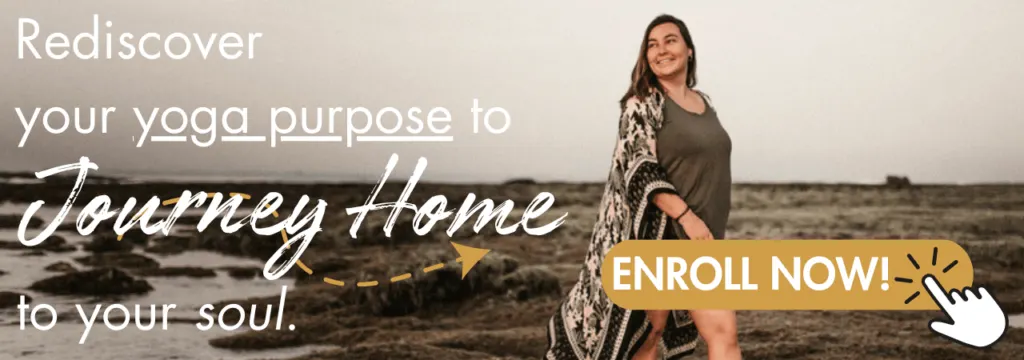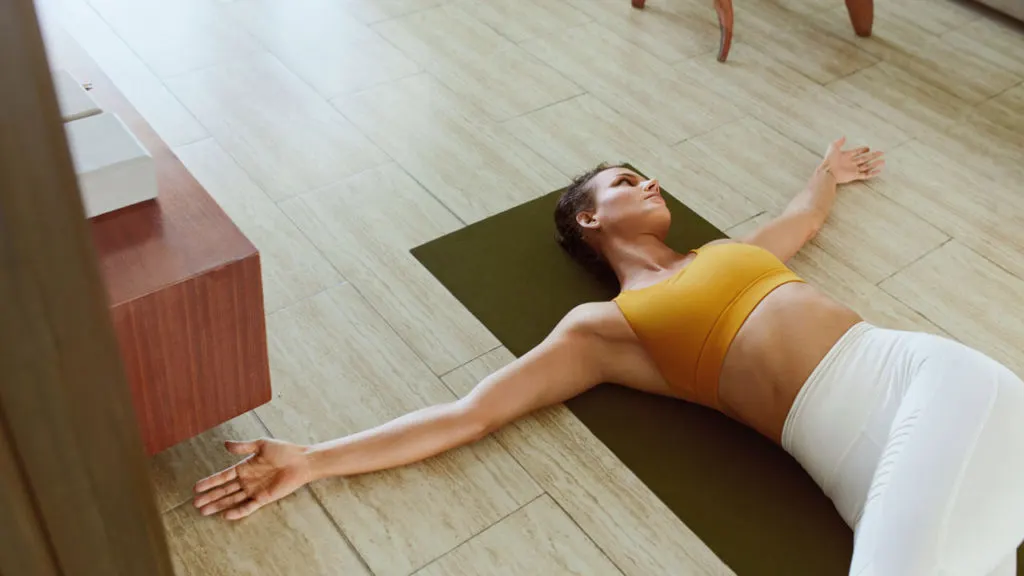Welcome! I hear that you want to start practicing yoga at home. I’m here to share some advice that makes it simple and relieves any stress or pressure you may put on yourself. I don’t believe in yoga as a weight loss tool or a workout (though it certainly can feel like it), or as something that needs to be practiced every day. I believe that yoga is a practice, consistency is important but not a deal breaker, and that there is a style of yoga out there for everyone. Let’s get to it!
How to Begin Your Yoga Practice
1. Release expectations
This here is your first lesson in yoga, to release expectations. This applies in multiple ways. Release your expectations of your practice looking how you want, release expectations of how consistent you might be, release expectations of how easy it will be (or hard), and release expectations of how you think your yoga practice will be like. Don’t have expectations for how long a yoga practice should be or how often. This will change over time, most likely.
From personal experience, yoga is almost never how I expected it to be. Your body can throw curve balls at you and affect how you practice, life will undoubtedly get in the way, and teachers will surprise you. Learning to release expectations and to allow your practice and your schedule to unfold in its natural way is a part of yoga. Just because you aren’t moving on the mat doesn’t mean you aren’t already practicing! Yoga is as much about the mind and your thoughts as it is about your body and stretching.

2. Know it will take time
It is okay if you don’t love your first yoga class. It’s okay if you hate the first teacher you practice with. It’s okay if it takes you a month to find your yoga groove or to finally find a yoga style that you love. Just like you won’t be able to slide into splits in your first class (maybe you can if you’re naturally flexible), don’t expect your yoga practice to begin without bumps. I don’t say this to discourage you from beginning a yoga practice at home, I say this to share that it’s totally normal. I have practiced with many teachers over years, tried multiple styles of yoga, and tried practicing in studio and online. Finding what feels best for me did not come over night or even in a month.
Sometimes it took me multiple classes with a teacher to appreciate their cues or personal flair, other times I just couldn’t find a way to dig a certain style. All I can encourage you to do is to show up for yourself. If you didn’t like something just notice and move on, doing your best to find something else that works for you, your mind and body, better.
Yoga is such a beautiful reflection of life and the journey you go through in creating a practice that feels best for you is just like how you learn what works for you in life too.
3. Pick a class, any class!
Seriously, just pick a class. You’re most likely doing a free class on YouTube so there is nothing stopping you from pressing pause and finding a new class if the original class you start isn’t your vibe. Start with any. Even if you just do 5 minutes, this will already begin to give you an idea of what works for you. A teachers voice, their cueing, the style of class, or the level, could all be determining factors. Don’t let anything not feeling great for you put you off from discovering the amazing benefits of this beautiful practice. It’s all about trial and error!
Don’t know which style of yoga to start with? Here’s a quick round-up to help you better understand:
- Vinyasa: One of the most popular styles, vinyasa links breath to movement and is more of a “flowy” kind of yoga.
- Hatha: A more traditional style of yoga, Hatha is a slower pace where poses are held for longer than vinyasa.
- Yin: A relaxed style of yoga that is almost all seated where poses are held for 3-5 minutes each. Yin is great for those who are stiff.
- Power: Power yoga is a stronger practice, very similar to vinyasa but often with more challenging poses such as arm balances (but not always).
- Kundalini: A powerful practice, Kundalini focuses more on your energy and is a mixture of repetitive movements, chanting, singing, and specific breathing techniques.
- Ashtanga: Also referred to as Ashtanga Vinyasa, the difference here is that Ashtanga has a set series of poses, but will move with the breath like a vinyasa class.
To get you started with yoga teachers, here are a few wonderful yoga channels to begin your search, because I know it can be very overwhelming!
- Taylor’s Tracks Yoga – Practice vinyasa and yin style classes with me! I focus on self love and self acceptance in my teachings
- Yoga with Adriene – Perhaps the most famous YouTube yoga teacher with lots of beginner classes
- Brett Larkin Yoga – So many options with Brett, from vinyasa to yin to Kundalini styles
- Yoga with Kassandra – A top spot for those interested in yin
- Sarah Beth Yoga – She has a little bit of everything, from prenatal to power to Hatha style classes

4. Choose a time of day that is most convenient for you
Your life should not revolve around yoga, but instead, yoga should fit into your schedule. This doesn’t mean that you have to practice at the same time every day. Does that help for consistency purposes? Yes. But does practicing when it feels good, not rushed, or scheduled promote a sense of ease? Also yes.
5. Use props from home
As a yoga teacher I always (always!!) suggest using yoga props. No, this does not make you a worse student or not as good at yoga. It means you are creating more space in your body through length, adding support to help relax and release, and strengthening. Props are a must in my eyes. And while I teach a lot of my classes with props, it doesn’t mean that you don’t have to run out and get them for your first class, or even your first while. Do I suggest getting props if you practice regularly? Absolutely! But hold off on the “fancy” equipment for now. No need to add complications to your practice!
Here’s what you can use from home instead of store-bought props:
- Instead of blocks use water bottles, cans, books, a folded blanket or towel, or a stiffer pillow.
- Instead of a bolster use a rolled blanket or towel or multiple pillows.
- Instead of a strap use the strap that you use to carry your yoga mat, or a towel bunched up.
READ MORE: Best Yoga Props Worth Investing In (When You’re Ready)

How to Stay Consistent in Your Yoga Practice
First I must clarify that staying consistent in your yoga practice does not mean practicing every day. How often you do yoga depends on you and what you feel like mentally and physically at given times of the month, life, and even throughout the week.
1. Join a challenge
While most yoga challenges are daily, they are a great way to kickstart your practice and keep you accountable. Many include extras such as email reminders and journal prompts (like my 7-day self love yoga challenge). A challenge can be anywhere from a week to 30 days, which are seen most frequently. Even if you don’t show up everyday, completing the challenge in your time will absolutely leave you with a sense of satisfaction and accomplishment for showing up for yourself.

2. Practice with a friend
Have a friend join your practice with you either by doing practices separately and checking in on each other to see if you’ve practiced or on how you’re feeling. Or try doing a live call as you both practice the same video. Having someone with similar goals alongside you makes it all the easier to keep going.
3. Add your practice to an existing habit or routine
While you don’t have to practice at the same time every day, doing so can help, especially so in the beginning. If you have a habit that you do daily or even a couple of times a week, tacking on your yoga practice to an existing habit makes it just that much easier for your body and mind to crave the similarity of your day or week. Perhaps you practice for 15 minutes before reading in bed, or after you water your plants. Find what works best for you!

4. Set an alarm
If you keep forgetting or really need a way to find time for your yoga practice then set an alarm on your phone with a reminder written to practice! It’s then up to you to follow through on your promise to yourself.
5. Lower your expectations
Don’t expect yourself to be perfect. Don’t expect yourself to show up exactly as planned. Life happens and yoga is all about adjusting to your life, its seasons, your emotions, and all. I broke my big toe and was off of my mat for almost 2 months. I certainly didn’t plan on it, but it taught me a valuable lesson of slowing down which I now love to teach in my yin and vinyasa classes. Release some of the pressure and remember that yoga is a practice. It’s less about consistency and more about showing up when you can.
What’s next?
- Journey Home is where to begin exploring what you need from your practice
- Want to explore beyond the physical? Sacred Exploration, my yoga privates, will support you through relinquishing your mental blocks. Book your intro session today!
- Experiment with your yoga practice with vinyasa, yin, and gentle classes on my YouTube channel

